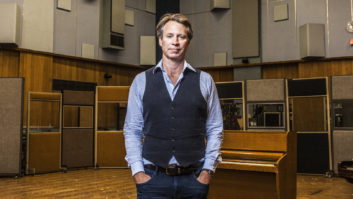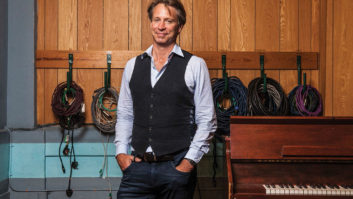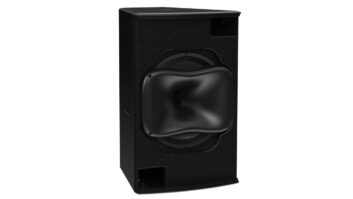Sydney, Australia––Wizard Projects, supported by the engineering team from Technical Audio Group (TAG) have installed a large 140-element Martin Audio OmniLine system in St Andrew’s Cathedral, Sydney. The system originally needed to be commissioned in time for the visit by the Duke and Duchess of Cambridge as part of their tour of Australia and New Zealand.
St. Andrew’s is the oldest cathedral in Australia and one of the city’s finest examples of Gothic Revival architecture; however such beautiful architecture comes at an acoustic cost with challenging reverberation times making clarity and evenness of coverage across the congregation a constant issue.
Having struggled with a sound system that failed to deliver clear speech intelligibility and effective live music reproduction, the church’s decision to install a new system reached emergency status with the Royal visit at hand.
Ross Cobb, Director of Music at St Andrew’s, and Canon Chris Allan were given the job of bidding for design, installation and commissioning of a state of the art system with absolutely no compromise in sound quality––to be fulfilled in just two weeks.
The task was awarded to Wizard Projects, led by senior engineer Michael Sheldrick with an electro acoustic design team of Glenn Leembruggen and David Gilfillan; the final piece in the jigsaw was the proven Martin Audio OmniLine micro line array, supplied by the manufacturer’s Australian distributor, Technical Audio Group.
Cobb had heard OmniLine in similar church installations and was impressed with the system’s consistent coverage, fidelity and low-key aesthetics.
The team identified a number of key design challenges: the church’s long RT time, sub bass placement and beam steering. The unusual logistics of church services involves a 360 degree presentation from the pulpit, a center transept area where choirs and clergy require sound reinforcement and a church where the congregation could sit anywhere at any service and expect perfect sound. On top of that, priests would move through the nave on headset radio mics with open mics for question and answer sessions.
Wizard’s design solution was to deploy an unprecedented 140 OmniLine elements (distributed over 22 hangs) along with six Martin Audio AQ212 dual 12 inch sub bass. Not only was the quantity of elements enormous but so was the DSP control.
Having used OmniLine in other reverberant environments they recognized that a unique aspect of the system is that it can be mechanically arrayed and aimed when used in passive mode but can also be deployed in an MLA [Multicellular Loudspeaker Array] active configuration.
In MLA mode, each element in the array is separately amplified and processed using FIR filters, based on custom software. This enables the system to not only be mechanically and electronically steered, but allows consistent frequency response throughout the listening area without the lobing associated with straight columns.
OmniLine is used in a combination of active arrays for the critical areas and passive hangs for spot fill, distributed across 60 channels of 200W-per-channel amps.
The main Western Nave arrays include two banks of 12 active OmniLines with a further two banks of 10 active arrays for the outer northwest pews, while the Eastern Nave has two banks of eight active elements with a further four positions of six active OmniLine for the center of the transept.
The sub bass system is floor mounted in two banks of three AQ212 with separate amplification and processing for each cabinet, which enables the low frequency to be electronically steered. According to TAG technical director, Anthony Russo, “Because OmniLine has such an extended and usable frequency response to 75Hz, the spectral balance between arrays and subs is even and consistent—a feature not normally associated with a compact array and large bass system.”
TAG also recommended advanced DSP and enabled the church to control the system with iPads, using custom designed GUI screens for simple services, or interfacing with the mixer and digital stage box for full scale services.
Other ingenious design features enable the pulpit’s local OmniLine, mounted a mere 19.6” above, to be ramped down, panned and re-EQed to its opposite partner array via the use of an under-carpet pressure mat whenever a priest uses the pulpit with a live mic. OmniLine’s smooth response is such that only 6dB reduction was required to achieve the pass mark required for gain before feedback criteria.
As Glenn Leembruggen commented, “OmniLine amazes every time we use it; the CAD and filtering predictions are absolutely usable; it’s an amazing engineering feat; there is nothing I have ever worked with that comes close to this product.”
And Canon Chris Allen added, “This has not only been an extraordinary effort but the compliments from the congregation on the clarity of the system are never ending.”
For more about Martin Audio, please click to www.martin-audio.com.
About OmniLine®
OmniLine is a versatile, micro-line array designed for installation in a wide variety of architectural environments. Its modular approach and scalability extend its use from foreground applications to sound reinforcement in large acoustic spaces. Intelligent software enables an array to be configured to deliver sound precisely over any vertical angle to fit the venue profile without spilling onto surfaces where sound is not required. Additionally, elimination of high-frequency side-lobes gives OmniLine the advantage over currently available DSP steered columns, making it suitable for high quality music reproduction as well as speech in large, reverberant spaces. Each array is constructed by connecting multiple modules. Up to 32 modules can be connected where both high output and vertical focusing down to low/mid frequencies are required. Smaller number of modules (down to 4) can be used for shorter-throw applications, where vertical focusing of the low/mid frequencies is less important. This scalability means that OmniLine can be used in a variety of applications. Visually, an OmniLine array is slim and unobtrusive, with soft lines that minimize its visual presence in an architectural environment.
About Martin Audio®
Founded by audio engineer David Martin in 1971, Martin Audio pioneered the use of all-horn-loaded bass designs in world-class touring loudspeaker systems for groups such as Pink Floyd, ELP and Supertramp. Located outside of London, Martin Audio now embodies a sophisticated mix of acoustic design, research, mathematical modeling and software engineering for a wide range of products in the installation, cinema and touring sound markets.







